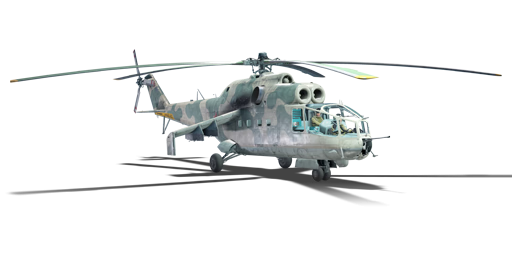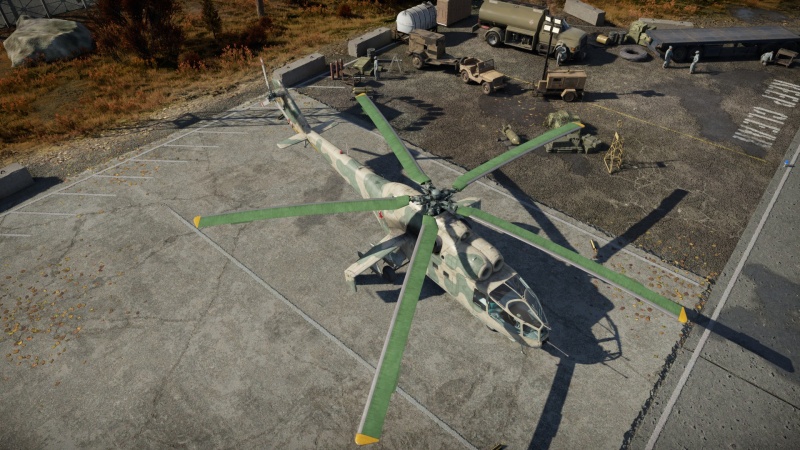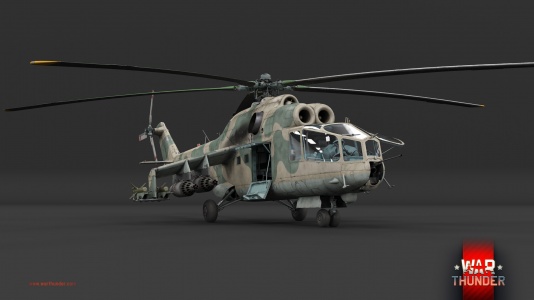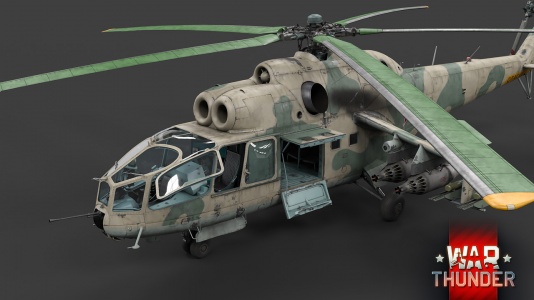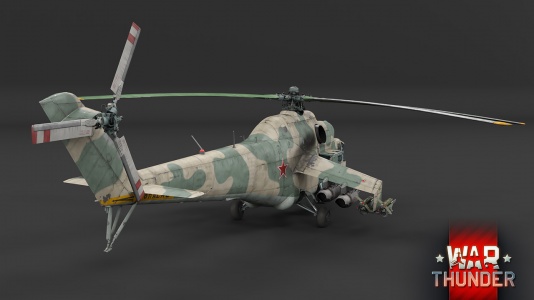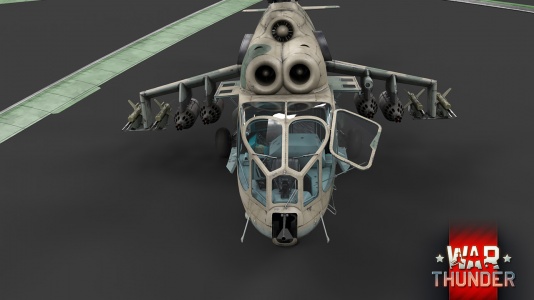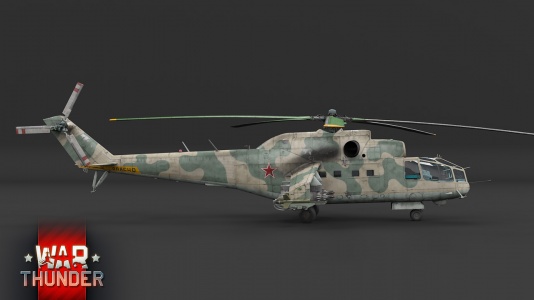Difference between revisions of "Mi-24A"
(Updated format) |
(Tag: Visual edit) |
||
| Line 73: | Line 73: | ||
=== Pros and cons === | === Pros and cons === | ||
| − | '' | + | '''Pros:''' |
| + | |||
| + | * Overall a more dynamic and pleasant attack helicopter gameplay than the slow [[Mi-4AV]] | ||
| + | |||
| + | * Really fast and manoeuvrable even during level flight | ||
| + | * Increase in the payload by 500 kg bombs; 250 kg bombs now carried simultaneously with ATGMs and rockets | ||
| + | * Several armour layers now protect the cockpit and gunner position | ||
| + | * The ballistic computer eases long-range rocket salvos | ||
| + | * Capable to fly with a single turboshaft engine at half thrust (55-60%) | ||
| − | |||
* | * | ||
'''Cons:''' | '''Cons:''' | ||
| + | |||
| + | * Larger and heavier than others helicopters; likely to go down after slightest rotor damage or high banking angles | ||
| + | * A slight left sideslip is notable; affects rocket salvos launching while moving (+220 km/h) | ||
| + | * A-12.7 machine gun is useless versus Mi-24's bigger threat: Aircraft | ||
| + | * No countermeasures or special imaging technology | ||
| + | |||
* | * | ||
== History == | == History == | ||
<!-- ''Describe the history of the creation and combat usage of the helicopter in more detail than in the introduction. If the historical reference turns out to be too long, take it to a separate article, taking a link to the article about the vehicle and adding a block "/History" (example: <nowiki>https://wiki.warthunder.com/(Vehicle-name)/History</nowiki>) and add a link to it here using the <code>main</code> template. Be sure to reference text and sources by using <code><nowiki><ref></ref></nowiki></code>, as well as adding them at the end of the article with <code><nowiki><references /></nowiki></code>. This section may also include the vehicle's dev blog entry (if applicable) and the in-game encyclopedia description (under <code><nowiki>=== In-game description ===</nowiki></code>, also if applicable).'' --> | <!-- ''Describe the history of the creation and combat usage of the helicopter in more detail than in the introduction. If the historical reference turns out to be too long, take it to a separate article, taking a link to the article about the vehicle and adding a block "/History" (example: <nowiki>https://wiki.warthunder.com/(Vehicle-name)/History</nowiki>) and add a link to it here using the <code>main</code> template. Be sure to reference text and sources by using <code><nowiki><ref></ref></nowiki></code>, as well as adding them at the end of the article with <code><nowiki><references /></nowiki></code>. This section may also include the vehicle's dev blog entry (if applicable) and the in-game encyclopedia description (under <code><nowiki>=== In-game description ===</nowiki></code>, also if applicable).'' --> | ||
| − | In studying the possibilities of helicopter design and the experience of other countries, Mikhail Leontyevich Mil came to the conclusion that a well-armed and | + | In studying the possibilities of helicopter design and the experience of other countries, Mikhail Leontyevich Mil came to the conclusion that a well-armed and armoured battle helicopter was required to increase the mobility of the Soviet Army. It had to be capable of transporting cargos and paratroopers – a kind of flying armoured car. In contrast to the American army, in which troop transport helicopters operated with cover from assault helicopters, Mikhail decided to create a vehicle that could handle both these tasks on its own. The engineers at the Mil design bureau already had considerable experience in developing helicopters, and had performed several experiments in transforming transport helicopters into assault helicopters. This meant that after military officials approved the concept of an assault-transport helicopter, the team immediately got to work. In the summer of 1969, literally a year after the work had begun, the Mil engineers presented a prototype for testing. |
The first version of the Mi-24 already had the characteristics and features familiar to all fans of military vehicles found in the later series-produced versions, the Mi-24B and the Mi-24D. The characteristic silhouette for which the Mi-24 was dubbed "Hind", two TVZ-117 turboshaft engines, retractable landing gear, a cargo bay for paratroopers and wings for mounting weaponry. However, there were differences also. The tail rotor on the Mi-24A was placed on the right – it was only moved to the left side in 1974. A single cabin was mounted on the Mi-24A with a flat glass, a so-called "Veranda" in which the armament operator and the pilot could sit one behind the other with a slight offset. The main difference was the armament. By the time the Mi-24 was created, the weaponry that the military demanded for the new helicopter – modern Shturm ATGMs with an advanced aiming kit, and a rapid-firing machine gun for the rotating nose turret – was not yet ready. The first versions of the Mi-24 were equipped with the Falanga-MV ATGM with manual aiming, the single-barrel A-12.7 in a turret with limited mobility on the nose with a simple collimator sight, and unguided rockets or up to 1000 kg of bombs on the wing hardpoints. Officially, the Mi-24A was never accepted into service, although quite a lot of the vehicles were built – along with the training versions, over 240 in total. The Mi-24A was exported, and took part in military operations in Ethiopia, Afghanistan and Libya. | The first version of the Mi-24 already had the characteristics and features familiar to all fans of military vehicles found in the later series-produced versions, the Mi-24B and the Mi-24D. The characteristic silhouette for which the Mi-24 was dubbed "Hind", two TVZ-117 turboshaft engines, retractable landing gear, a cargo bay for paratroopers and wings for mounting weaponry. However, there were differences also. The tail rotor on the Mi-24A was placed on the right – it was only moved to the left side in 1974. A single cabin was mounted on the Mi-24A with a flat glass, a so-called "Veranda" in which the armament operator and the pilot could sit one behind the other with a slight offset. The main difference was the armament. By the time the Mi-24 was created, the weaponry that the military demanded for the new helicopter – modern Shturm ATGMs with an advanced aiming kit, and a rapid-firing machine gun for the rotating nose turret – was not yet ready. The first versions of the Mi-24 were equipped with the Falanga-MV ATGM with manual aiming, the single-barrel A-12.7 in a turret with limited mobility on the nose with a simple collimator sight, and unguided rockets or up to 1000 kg of bombs on the wing hardpoints. Officially, the Mi-24A was never accepted into service, although quite a lot of the vehicles were built – along with the training versions, over 240 in total. The Mi-24A was exported, and took part in military operations in Ethiopia, Afghanistan and Libya. | ||
| Line 93: | Line 106: | ||
;Skins | ;Skins | ||
| + | |||
* [https://live.warthunder.com/feed/camouflages/?vehicleCountry=ussr&vehicleType=helicopter&vehicleClass=attack_helicopter&vehicle=mi_24a Skins and camouflages for the {{PAGENAME}} from live.warthunder.com.] | * [https://live.warthunder.com/feed/camouflages/?vehicleCountry=ussr&vehicleType=helicopter&vehicleClass=attack_helicopter&vehicle=mi_24a Skins and camouflages for the {{PAGENAME}} from live.warthunder.com.] | ||
| Line 109: | Line 123: | ||
== See also == | == See also == | ||
''Links to the articles on the War Thunder Wiki that you think will be useful for the reader, for example:'' | ''Links to the articles on the War Thunder Wiki that you think will be useful for the reader, for example:'' | ||
| + | |||
* ''reference to the series of the helicopter;'' | * ''reference to the series of the helicopter;'' | ||
* ''links to approximate analogues of other nations and research trees.'' | * ''links to approximate analogues of other nations and research trees.'' | ||
| Line 117: | Line 132: | ||
* ''encyclopedia page on the helicopter;'' | * ''encyclopedia page on the helicopter;'' | ||
* ''other literature.'' --> | * ''other literature.'' --> | ||
| + | |||
* [[wt:en/news/5736-development-mi-24a-the-impeccable-hind-en|[Devblog] Mi-24A: The impeccable Hind]] | * [[wt:en/news/5736-development-mi-24a-the-impeccable-hind-en|[Devblog] Mi-24A: The impeccable Hind]] | ||
{{AirManufacturer Mil}} | {{AirManufacturer Mil}} | ||
{{USSR helicopters}} | {{USSR helicopters}} | ||
Revision as of 05:32, 31 March 2021
| This page is about the Russian attack helicopter Mi-24A. For other uses, see Mi-24 (Family). |
Contents
Description
The Mi-24A is a rank V Soviet attack helicopter with a battle rating of 9.3 (AB), 8.7 (RB), and 9.0 (SB). It was introduced in Update 1.81 "The Valkyries".
General info
Flight performance
Describe how the helicopter behaves in the air. Speed, manoeuvrability, acceleration and allowable loads - these are the most important characteristics of the vehicle.
| Characteristics | Max Speed (km/h at 1,000 m) |
Max altitude (metres) | |
|---|---|---|---|
| AB | RB | ||
| Stock | 317 | 303 | 4950 |
| Upgraded | ___ | 335 | |
Survivability and armour
Examine the survivability of the helicopter. Note how vulnerable the structure is and how secure the pilot is, whether the fuel tanks are armoured, etc. Describe the armour, if there is any, and also mention the vulnerability of other critical systems.
Modifications and economy
Armaments
Offensive armament
The Mi-24A is armed with:
- 1 x 12.7 mm A-12.7 machine gun, nose turret (900 rpg)
Suspended armament
The Mi-24A can be outfitted with the following ordnance:
- Without load
- 128 x S-5K rockets
- 4 x 9M17M Falanga missiles
- 4 x 250 kg OFAB-250sv bombs (1,000 kg total)
- 2 x 500 kg FAB-500M-54 bombs (1,000 kg total)
- 4 x 9M17M Falanga missiles + 128 x S-5K rockets
- 4 x 9M17M Falanga missiles + 4 x 250 kg OFAB-250sv bombs (1,000 kg total)
- 4 x 9M17M Falanga missiles + 2 x 500 kg FAB-500sv bombs (1,000 kg total)
- 4 x 9M17M Falanga missiles + 2 x 250 kg OFAB-250sv bombs + 64 x S-5K rockets (500 kg total)
Usage in battles
Describe the tactics of playing in a helicopter, the features of using the helicopter in a team and advice on tactics. Refrain from creating a "guide" - do not impose a single point of view, but instead, give the reader food for thought. Examine the most dangerous enemies and give recommendations on fighting them. If necessary, note the specifics of the game in different modes (AB, RB, SB).
Pros and cons
Pros:
- Overall a more dynamic and pleasant attack helicopter gameplay than the slow Mi-4AV
- Really fast and manoeuvrable even during level flight
- Increase in the payload by 500 kg bombs; 250 kg bombs now carried simultaneously with ATGMs and rockets
- Several armour layers now protect the cockpit and gunner position
- The ballistic computer eases long-range rocket salvos
- Capable to fly with a single turboshaft engine at half thrust (55-60%)
Cons:
- Larger and heavier than others helicopters; likely to go down after slightest rotor damage or high banking angles
- A slight left sideslip is notable; affects rocket salvos launching while moving (+220 km/h)
- A-12.7 machine gun is useless versus Mi-24's bigger threat: Aircraft
- No countermeasures or special imaging technology
History
In studying the possibilities of helicopter design and the experience of other countries, Mikhail Leontyevich Mil came to the conclusion that a well-armed and armoured battle helicopter was required to increase the mobility of the Soviet Army. It had to be capable of transporting cargos and paratroopers – a kind of flying armoured car. In contrast to the American army, in which troop transport helicopters operated with cover from assault helicopters, Mikhail decided to create a vehicle that could handle both these tasks on its own. The engineers at the Mil design bureau already had considerable experience in developing helicopters, and had performed several experiments in transforming transport helicopters into assault helicopters. This meant that after military officials approved the concept of an assault-transport helicopter, the team immediately got to work. In the summer of 1969, literally a year after the work had begun, the Mil engineers presented a prototype for testing.
The first version of the Mi-24 already had the characteristics and features familiar to all fans of military vehicles found in the later series-produced versions, the Mi-24B and the Mi-24D. The characteristic silhouette for which the Mi-24 was dubbed "Hind", two TVZ-117 turboshaft engines, retractable landing gear, a cargo bay for paratroopers and wings for mounting weaponry. However, there were differences also. The tail rotor on the Mi-24A was placed on the right – it was only moved to the left side in 1974. A single cabin was mounted on the Mi-24A with a flat glass, a so-called "Veranda" in which the armament operator and the pilot could sit one behind the other with a slight offset. The main difference was the armament. By the time the Mi-24 was created, the weaponry that the military demanded for the new helicopter – modern Shturm ATGMs with an advanced aiming kit, and a rapid-firing machine gun for the rotating nose turret – was not yet ready. The first versions of the Mi-24 were equipped with the Falanga-MV ATGM with manual aiming, the single-barrel A-12.7 in a turret with limited mobility on the nose with a simple collimator sight, and unguided rockets or up to 1000 kg of bombs on the wing hardpoints. Officially, the Mi-24A was never accepted into service, although quite a lot of the vehicles were built – along with the training versions, over 240 in total. The Mi-24A was exported, and took part in military operations in Ethiopia, Afghanistan and Libya.
- From Devblog
Media
- Skins
- Images
- Videos
See also
Links to the articles on the War Thunder Wiki that you think will be useful for the reader, for example:
- reference to the series of the helicopter;
- links to approximate analogues of other nations and research trees.
External links
| Mil Moscow Helicopter Plant | |
|---|---|
| Attack | Mi-4AV |
| Mi-8AMTSh · Mi-8AMTSh-VN · Mi-8TV | |
| Mi-24A · Mi-24P · Mi-24V | |
| Mi-28N · Mi-28NM | |
| Mi-35M | |
| Export | ◊Mi-8TB |
| ▂Mi-24D · ◔Mi-24D · ◔Mi-24V · ◔Mi-24P · ◊Mi-24P · ◄Mi-24P HFS 80 · Superhind | |
| Mi-28A | |
| ▄Mi-35M | |
| USSR helicopters | |
|---|---|
| Attack | |
| Hound | Mi-4AV |
| Hip | Mi-8AMTSh · Mi-8AMTSh-VN · Mi-8TV |
| Hind | Mi-24A · ▂Mi-24D · Mi-24P · Mi-24V · Mi-35M |
| Havoc | Mi-28N · Mi-28NM |
| Helix | Ka-29 |
| Hokum | Ka-50 · Ka-52 |


